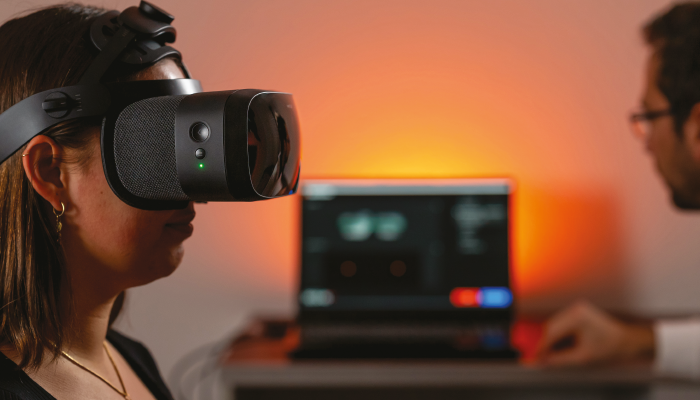
Credit: machineMD
Swiss company machineMD’s virtual reality (VR) medical device, neos, was recently certified as a Class IIa medical device under the European Union Medical Device, making it the first EU-MDR medical device that can comprehensively assess eye movements, pupillary function, and visual fields.
We spoke to the company’s Chief Commercial Officer, Phil Norris, about the neos’s potential to impact the field of neuro-ophthalmology.
Can you explain the technology behind the neos device?
Phil Norris: The core technology is a VR headset that provides gamified stimuli to each eye individually, with integrated eye tracking that measures the resulting eye movements and pupillary responses. This eye tracking runs at 200Hz, which is necessary to analyze particular biomarkers of fast eye movements, such as saccadic intrusions and peak velocity of prosaccade responses. The device features a standardized, automated protocol for the systematic assessment of afferent and efferent visual function, including ocular alignment, pupillometry, eye movements, and visual fields.
How can it address the current gaps in neuro-ophthalmology?
The low number of neuro-ophthalmologists and orthoptists globally results in extremely long referral times, typically more than six months in the US. Indeed, six US states have no neuro-ophthalmologist at all. And clinical assessments are currently performed manually, which are challenging when attempting to accurately measure and monitor eye movements such as nystagmus, saccades, and pupillometry.
Traditional methods of eye movement and pupillometry examinations are performed by a variety of healthcare professionals, ranging from neuro-ophthalmologists to emergency medicine doctors and their supporting technicians and assistants. This can lead to misdiagnosis. Our primary advantage is providing a systematic objective assessment that is reported quantitatively. The neos can identify symptoms that are frequently missed or mis-classified, such as relative afferent pupillary defect (RAPD).
How would the device integrate with existing clinical workflows in ophthalmology?
The clinical workflow is simple, as a technician can perform the test with a patient in a general-purpose space. This information can be gathered for all patients entering an eye clinic, and captures the data before additional workup is performed, in particular the pupillometry data before pupils are dilated. Patients also benefit from wearing the ergonomic VR headset, as opposed to traditional analysis devices that require patients to be steady on a chin rest and to coordinate subjective responses with a clicker. Also, its quantitative reports are securely stored on a cloud-based platform and easily exportable to electronic health record systems.
How do you see the technology improving outcomes for patients with neuro-ophthalmic conditions?
Based on our ongoing research in diseases such as Parkinson’s and multiple sclerosis, we expect to further develop the device to improve disease monitoring and, ultimately, enable earlier diagnosis of neurodegenerative and neuroinflammatory diseases. There is a wealth of literature that identifies significant biomarkers based on functional eye assessments; however, the wealth of peer reviewed publications is based on customized research-grade equipment. The neos, however, provides a standardized test protocol from which we are developing the oculometric biomarkers that will complement structural imaging, both of the eye (e.g., via OCT) and of the brain (e.g., via MRI scans).
